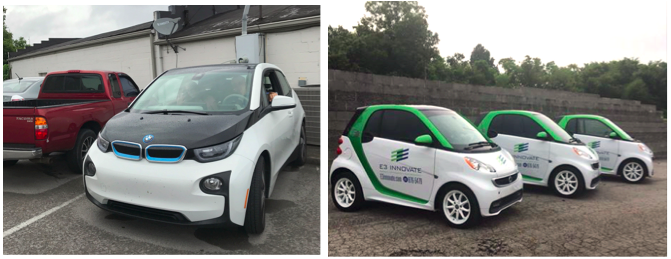As a company who focuses on energy efficiency, our fundamental objective here at E3 INNOVATE is to promote sustainable living however possible. Although on a day-to-day basis we achieve this by creating high performance homes, we hope to inspire others to think about the bigger picture long after our work is complete. We believe the home is the centerpiece for a sustainable lifestyle. It is from here that we make choices about our health, food, transportation, and other consumable and durable goods.
Although traditionally we have achieved our objective through green building science, we recently embraced an entirely new way of improving our sustainability. Over the last three months, we incorporated a total of four electric vehicles into our fleet, which have helped us reach higher efficiency goals. This acquisition quickly proved to embody E3’s motto of Energy, Efficiency, and Environment and has helped us understand the role electric vehicles play in an evolving transportation sector.
Earlier this year, Erik Daugherty, founder and owner of E3, had the initial idea of obtaining an electric car to replace the functionality of a Volkswagen TDI station wagon that would be leaving the fleet. Inspired by his use of a gas-powered Smart Car while living in Europe 15 years ago, Erik believed the electric Smart Car was the clear choice for E3’s growing transportation needs. He says,
“When the opportunity arose to obtain the Smart Car, choosing electric was simple – it’s a solution that gives us the ability to do our work efficiently while reducing our environmental footprint and our cost.”
Beyond that, Erik appreciates the cradle-to-cradle design of the vehicle. Smart Cars can it can be disassembled quickly and many components are recyclable.

Since May, E3 has obtained four electric vehicles: three Smart Cars and one BMW i3, all of which have become essential for everyday tasks. Members of the E3 team enjoy driving these new cars for a variety of reasons, including:
- “How easy parking is”
- “It’s everything I need – plenty of cargo space for a day’s work – quick, comfortable, and reliable”
- “Hold plenty of charge for a day’s worth of driving and can be charged easily when needed”
- “The potential of being able to charge up with solar energy is really cool! A car that runs on solar energy? That’s neat.”
Lesley Herrmann, the business development specialist here at E3, likes the new electric cars because, “They initiate conversations about sustainable living”. She says, “It’s not just about your house at E3, but about lifestyle. These cars really set a positive example and I’m glad we can be that example in our community.” Needless to say, these new electric cars have received a warm welcome from the E3 team.
More important than their convenience, however, are these electric vehicles serving their purpose of reducing E3’s carbon footprint? The answer, though complicated, is ultimately a solid yes.
The MPG equivalent (MPGe) for electric cars ranges anywhere between 31 to 160 across the country, with an average of 73 MPGe (1). This range is dependent on the source of energy used for electricity generation, which varies from state to state. According to The Union of Concerned Scientists (UCS), when charged using electricity generated in Tennessee, a Smart Car and a BMW i3 have efficiencies of 51 MPGe (2) and 60 MPGe (3) respectively compared to internal combustion cars. Given that the average US car has an efficiency of 25 MPG (4), both of these cars perform over twice as well as the average gasoline car — and therefore generate only half the emissions.
The level of efficiency of these cars in Tennessee fits within the average the UCS claims most electric cars obtain: “New UCS analysis finds that, over its lifetime—from manufacturing to operation to disposal—a battery electric vehicle generates about 50 percent fewer global warming emissions than a comparable gasoline car (5)”. Obtaining these electric cars has been a worthwhile endeavor for E3; they not only cut our emissions (and our energy costs), they help E3 stay committed to forward-thinking innovations.

It’s imperative that we reduce the impact of our transportation on the planet and electric vehicles are becoming an important piece of the puzzle. However, we cannot overlook the finite amount of natural resources needed for their production. As some European countries prepare to go all-electric by 2040, we must be careful not to trade the dependence of one commodity, foreign oil, for another, rare earth metals, which are necessary for components of the electric motor.
In general, and for the millions of daily commuters out there, we need a more sustainable way to move a lot of people with fewer resources. Electrified mass-transit is a great way to do this. Lesley recalls her time living in Colorado,
“I knew multiple people who didn’t own a vehicle because the public transportation system worked extremely well. I rode the bus to work every day because it was less stressful and safer than driving.”
In addition to local and regional bus services, the Denver area has an electric lightrail system that rapidly expanded in the last few years, totaling nine different rail lines and 86.5 miles of service.
Although an electric lighrail may be the most appealing to commuters, let’s not forget about electric buses and their ease of adoption. The electrification of buses makes great sense from a physics standpoint too. Electric motors can provide a lot of torque, which is helpful for accelerating a heavy bus from a dead stop. The stop-and-go nature of busses also fits well within the functionality of regenerative breaking.
Our transportation sector is moving in a cleaner direction with the use of electric vehicles, but let’s not overlook the need and effectiveness of electrified mass-transit systems as a way to further improve the sustainability of our cities.
Check out this video by the UCS for more information on the environmental impact of electric cars.









